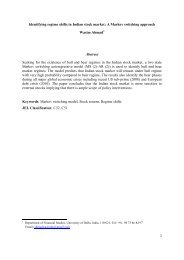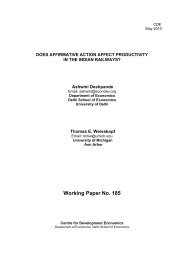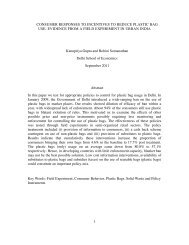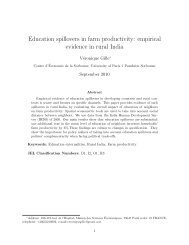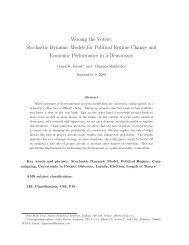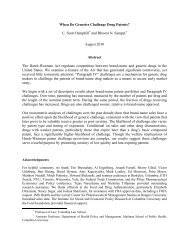Dismantling the Legacy of Caste - Centre For Development Economics
Dismantling the Legacy of Caste - Centre For Development Economics
Dismantling the Legacy of Caste - Centre For Development Economics
Create successful ePaper yourself
Turn your PDF publications into a flip-book with our unique Google optimized e-Paper software.
Our setting provides a way around <strong>the</strong>se two problems for research design. <strong>For</strong> our study, we use<br />
data on admissions to over 210 engineering colleges. The students in all colleges are admitted through a<br />
fully transparent common admission system laid out by <strong>the</strong> state government. Colleges have discretion in<br />
<strong>the</strong> admission for up to 20 percent <strong>of</strong> <strong>the</strong>ir available seats. Admission for <strong>the</strong> remaining 80 percent <strong>of</strong><br />
seats is through <strong>the</strong> common admission system. The affirmative action policies mandate that 50 percent<br />
<strong>of</strong> <strong>the</strong>se seats in each college be set aside for students belonging to six different castes. 2<br />
Moreover, <strong>the</strong><br />
policy specifies <strong>the</strong> proportion <strong>of</strong> those seats that are to be allocated to members <strong>of</strong> each <strong>of</strong> those castes.<br />
We know for each student his or her caste or social group, <strong>the</strong> name <strong>of</strong> <strong>the</strong> college, and whe<strong>the</strong>r <strong>the</strong><br />
student was admitted under affirmative action. Secondly, most <strong>of</strong> <strong>the</strong>se colleges are affiliated to one<br />
university, which sets a common curriculum for all <strong>the</strong> disciplines and administers a common<br />
examination to all students. 3<br />
This enables us to compare academic performance <strong>of</strong> all students in <strong>the</strong>se<br />
colleges.<br />
Affirmative action can potentially benefit members <strong>of</strong> disadvantaged castes in two ways.<br />
Affirmative action enables some applicants to attend college who could o<strong>the</strong>rwise not have obtained<br />
admission to any college, and affirmative action increases priority in selection among college for those<br />
who would have attended a college in <strong>the</strong> absence <strong>of</strong> affirmative action. We find significant effects <strong>of</strong><br />
affirmative action on both <strong>of</strong> <strong>the</strong>se measures. Affirmative action increases college attendance, with<br />
effects that are proportionately greatest for <strong>the</strong> members <strong>of</strong> <strong>the</strong> most disadvantaged castes. Similarly, we<br />
find that improved priority in college selection improves achievement, again with proportionately greater<br />
effects accruing to members <strong>of</strong> <strong>the</strong> most disadvantaged castes. Finally, we observe that for members <strong>of</strong><br />
all castes, an increase in priority for college choice results in improved academic achievement in college;<br />
<strong>the</strong>re is no evidence <strong>of</strong> mismatch harming intended beneficiaries.<br />
2 As discussed below, <strong>the</strong> Indian constitution, implemented in 1950, mandates affirmative action for Scheduled<br />
<strong>Caste</strong>s (historically ―untouchables‖) subjected to <strong>the</strong> most severe economic and social discrimination, and Scheduled<br />
Tribes, isolated both geographically and culturally. Affirmative action has subsequently been extended by law to<br />
o<strong>the</strong>r disadvantaged castes, with variation across <strong>the</strong> states <strong>of</strong> India.<br />
3 A small number <strong>of</strong> colleges admit students under <strong>the</strong> common admission system, but are not affiliated to this<br />
university. As detailed below, we include <strong>the</strong>se students in our analysis <strong>of</strong> <strong>the</strong> effects <strong>of</strong> affirmative action on<br />
admission, but we do not include <strong>the</strong>se students in our analysis <strong>of</strong> <strong>the</strong> effects <strong>of</strong> affirmative action on achievement.<br />
3



